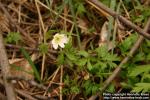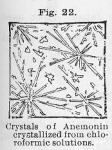
 Related entries: Anemone Patens.—American Pulsatilla - Pulsatilla (U. S. P.)—Pulsatilla
Related entries: Anemone Patens.—American Pulsatilla - Pulsatilla (U. S. P.)—Pulsatilla
The whole plant of Anemone nemorosa, Linné.
Nat. Ord.—Ranunculaceae.
COMMON NAMES: Wind flower, Wood anemone, Wind crowfoot.
ILLUSTRATION: Drugs and Medicines of North America, by J. U. and C. G. Lloyd, Vol. I, p. 22.
Botanical Source.—"This is a graceful little plant, about 4 inches high, which blossoms in early spring, and is found in open woods. The root is a slender, horizontal root-stalk. The stem, which is produced from the extremity of the root-stalk, is simple, slender, erect, and leafless, except at the top, where it bears a whorl of three-petiolate, three-parted floral leaves, and a solitary, small, peduncled, white, or purplish flower. This little plant is of wide distribution in this country and also in Europe" (C. G. Lloyd, in Drugs and Medicines of North America, p. 21).
History and Chemical Composition.—This plant blossoms in April and May. "Anemone nemorosa abounds in an acrid juice, which is particularly intense in the root. These properties disappear when the plant is dried, and hence only the recent plant, or preparations of the recent plant, are of value in medicine. In consequence of this fact, the dried plant is not a commercial drug, and doubtless, like others of this family, the uncertain nature of the plant when dry has prevented it from becoming a recognized remedy" (Prof. J. U. Lloyd, in Drugs and Medicines of North America, p. 22).
The acrid properties of this plant are due to a principle subsequently mentioned—a principle that is dissipated even in drying the plant; hence the dried drug is practically inert. According to Prof. J. U. Lloyd (Drugs and Medicines of North America, p. 22), a tincture of the fresh plant affords the only reliable representative of the drug. According to Linnaeus, it produced in cattle feeding upon the plant both dysentery and bloody urine.
 Anemonin (C10H8O4) Beckurts, 1892), occurs not only in the herbs of A. nemorosa, but also of A. Pulsatilla, L., A. pratensis, L., Ranunculus reptans, L., R. acer, L. (45 pounds yielded 11.5 Gm.) and R. sceteratus, L., and the leaves of Clematis angustifolia and C. integrifolia. It is obtained by distilling the plants with water, and either setting the product aside, allowing it to crystallize, or shaking out the distillate with chloroform. From this solution anemonin first crystallizes, and afterwards a substance called anemone camphor, which is a very unstable compound having a sharp odor, irritating the mucous membranes of the nose, etc. It readily splits into anemonin and amorphous isanemonic acid. To this property of anemone camphor are accredited the evanescent physiological properties of the drug.
Anemonin (C10H8O4) Beckurts, 1892), occurs not only in the herbs of A. nemorosa, but also of A. Pulsatilla, L., A. pratensis, L., Ranunculus reptans, L., R. acer, L. (45 pounds yielded 11.5 Gm.) and R. sceteratus, L., and the leaves of Clematis angustifolia and C. integrifolia. It is obtained by distilling the plants with water, and either setting the product aside, allowing it to crystallize, or shaking out the distillate with chloroform. From this solution anemonin first crystallizes, and afterwards a substance called anemone camphor, which is a very unstable compound having a sharp odor, irritating the mucous membranes of the nose, etc. It readily splits into anemonin and amorphous isanemonic acid. To this property of anemone camphor are accredited the evanescent physiological properties of the drug.
Anemonin forms white needles having a fusing point at 150 to 152° C. (302 to 305.6° F.). It is without odor and taste, and of neutral reaction to litmus, but acquires a burning taste when melted. It volatilizes with the vapors of boiling water, and is quite irritating under this condition. It is slightly soluble in cold water and alcohol, more readily in chloroform and fixed oils, but not in ether. Alkalies readily combine with it. Anemonic acid (C10H10O5) also occurs in the herb, together with anemoninic acid (C10H12O6). The former, occurring in white needles with the fusing point 250° C. (410° F.), may be obtained by boiling anemonin with lead oxide; the latter by warming anemonin with diluted acids (Beckurts, Amer. Jour. Pharm., 1892).
Action, Medical Uses, and Dosage.—This plant is acrid and poisonous. It has been recommended in amaurosis and other diseases of the eye, secondary syphilis, cutaneous diseases, and whooping-cough, in doses of 1 or 2 grains daily. These, however, are its old-time uses. When applied locally it is said to be efficient in scald-head. In the recent state, the leaves bruised and applied to the skin are rubefacient. In large doses this article produces nausea, vomiting, looseness of the bowels, and hematuria. Prof. Edwin M. Hale, M. D., states that it is not in use among the homoeopaths, and that he has heard of several cases of poisoning by it in which the toxic effects were similar to those of pulsatilla, but much more severe. He suggests that as a remedy it might occupy a place between aconite and pulsatilla (Drugs and Medicines of North America). Prof. Scudder (Spec. Med.) writes: "It influences the functions of waste and repair, but works directly upon the nervous system." The remedy will repay study, and is suggested as of probable value in skin diseases, and, we might add, nervous derangements. The drug referred to by Webster as "Pulsatilla Nuttalliana," or "Anemone nemorosa," is undoubtedly Anemone patens, var. nuttalliana, which see. A tincture of the fresh plant in fruit (℥viij to alcohol Oj) may be tried in doses of a fraction of 1 drop to 5 drops.
Related Species.—Anemone cylindrica, Gray. United States. Distinguished by cylindrical fruit-heads. Used by the Indians for the cure of rattlesnake bite. Their mode of using it is to chew some of the tops of the plant, swallowing but little of the saliva, and then applying it to the bite; in a few minutes the poison is rendered harmless. When chewed the tops have a hot, pungent taste, somewhat like capsicum. All the anemones are useful in menstrual suppression, and all are likewise acrid and poisonous.
Anemone virginiana, Linné. Wood flower, Wind flower, Thimble weed. An herb growing from 2 to 3 feet high, having from 2 to 4 greenish-white flowers; distinguished also by its oblong head of wooly achenes. Reputed to have similar properties to those of Anemone nemorosa. According to Kalm, the seeds relieve toothache if dipped in alcohol and placed in the tooth cavity. Porcher states that it will remove corm (Drugs and Medicines of North America, Vol. I).
Anemone patens, var. Nutalliana (see Anemone patens).
Anemone coronaria, Linné. Levant. Occasionally cultivated. Used medicinally to a slight extent.
Anemone cernua, Thunberg. White-headed old man. China and Japan. Root used medicinally.
Anemone sylvestris, Linné. Europe and North Asia. This and the next species employed by the Siberians.
Anemone ranunculoides, Linné. Europe and Siberia.
Anemone pratensis, Linné, and A. Pulsatilla, Linné (see Pulsatilla).

